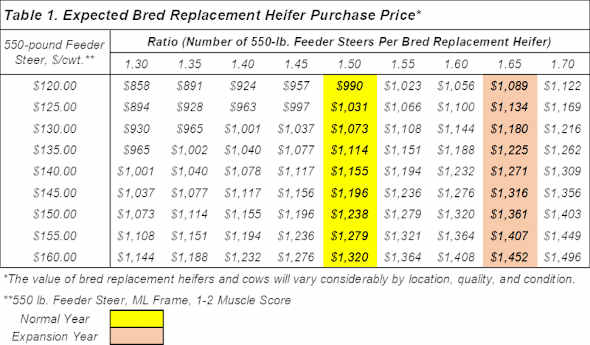By Chris Prevatt
As the U.S. cattle industry turns the corner of this cattle cycle producers have begun asking the question, “How much should I pay for a bred replacement heifer this year?” This is indeed a tough question to answer because cow-calf producers and their operations are vastly different. That is, some producers have better soils, forages, cattle, resources, and management than others. These top managers can afford to pay more for bred replacement heifers.
Producers have historically referenced bred replacement heifers in terms of how many calves are needed to pay for a bred replacement heifer or cow, while ignoring production costs. Over the last 30 years, the cost of a bred replacement heifer has averaged 1.5 times the price of a 550-pound feeder steer. However, in years where U.S. cowherd expansion has taken place the ratio can move up to 1.65. By knowing the price relationship between the cost of a bred replacement heifer and a 550-pound feeder steer, cow-calf producers have some guidance on how much they can pay for bred replacement heifers this fall.
During the next decade, there will be a wide range of prices for bred replacement heifers. Price levels this fall will vary for many heifers due to producers’ focus on quality versus quantity, location, condition, value, and genetics. Producers can use the table below as a guide when purchasing bred replacement heifers. Table 1 describes the expected purchase price of bred replacement heifers for various feeder steer prices ($/cwt.), and the ratio of 550-pound feeder steers needed to pay for a bred replacement heifer. For example, if 550-pound feeder steers sell at $120/cwt. with a normal ratio of 1.50, the expected purchase price of a bred replacement would be $990. But during expansion, when bred heifers are in higher demand, the ratio shifts to 1.65, resulting in the expected purchase price of $1,089. Thus, in this table the expected purchase prices of bred replacement heifers range from $858 to $1,496, based on the combinations of 550-pound feeder steer prices and the steer to heifer price ratios listed.

Currently, 550-pound feeder steers are averaging around $140/cwt. in the Southeast. This feeder steer price implies an expected purchase price for bred replacement heifer of $1,155 per head, or 1.5 times the value of a 550-pound feeder steer in a normal year. In years when the U.S. cattle industry is in the expansion phase of the cattle cycle, the ratio is increased to 1.65. Assuming a 550-pound feeder steer price of $140/cwt. and a ratio of 1.65, the expected purchase price for bred replacement heifers would be $1,271 per head.
Table 2 describes the number of calves needed to pay for a bred replacement heifer. It ranges from 1.14 to 3.11 (550-pound feeder steers) for the various feeder steer market prices and the expected purchase price of bred replacement heifers.
The price of bred replacement heifers is ultimately decided by a willing buyer and a willing seller. With both being fully informed about stronger consumer beef demand, a reduction in U.S. Cattle Inventory, and higher feeder calf prices on the horizon, cow-calf producers should expect to pay higher prices for bred replacement heifers over the next decade.
Source : ufl.edu